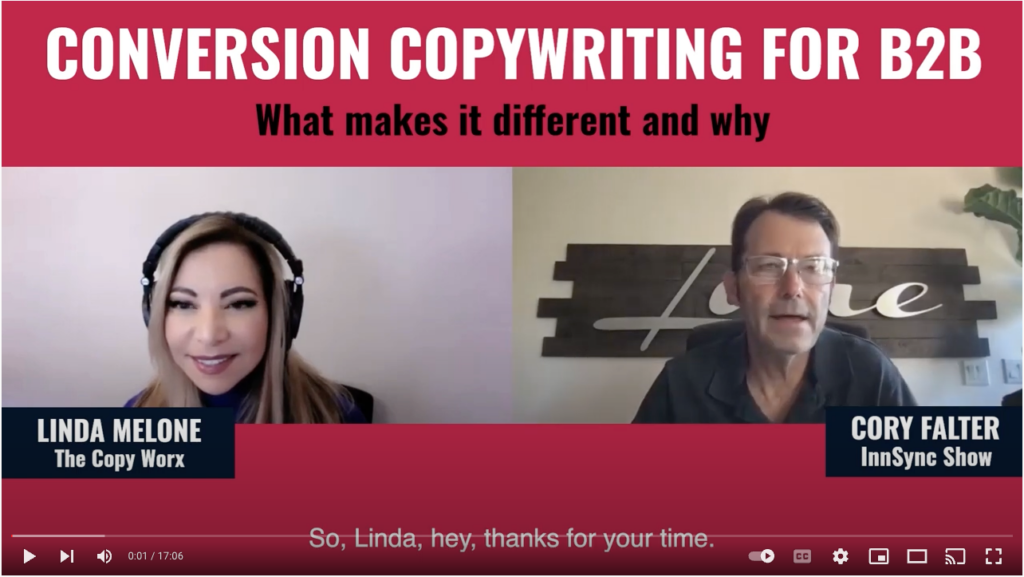
Imagine crafting content so compelling that it easily convinces your prospects to become buyers. That's the power of conversion copywriting.
Conversion copywriting is the art and science of writing persuasive content that helps convince your readers to take a desired action; this could be anything from subscribing to a newsletter to making a purchase.
While it may seem daunting, crafting effective conversion copy doesn't have to be complicated. In fact, by following a few simple tips, you can start writing copy that boosts conversions and helps drive results for your business.
Here are some ideas, with a little help from our friend and B2B Copywriter and Marketing Strategist, Linda Melone.
Getting Started with Conversion Copywriting
Conversion copywriting is an essential skill for any marketer or business owner who wants to increase their website's conversion rate - that is, the percentage of visitors who take a desired action.
Because of an often-longer sales cycle, B2B organizations rely on building relationships. While conversion copywriting is solely based on revenue, each step in the journey is equally important. You want to guide your prospect through each stage in the journey easily.
Conversion copywriting can help you create content that speaks to your audience's needs and concerns and persuades them to take the next step in the relationship.
Linda says there are three areas conversion copywriters focus on that differ from traditional copywriting.
- The level of market sophistication. In other words, is the product or service a well-known commodity? In other words, is it a highly competitive field or very niche?
- The stage of awareness a prospect will have before showing up on your website. Were they previously aware of your product or service? Are they aware of how much of a problem they may have and whether they need a solution?
- The use of proven copywriting formulas. Not to be confused with templates! One common formula for creating content is the PAS (problem, agitation, solution) formula.
These are proven ways to get people from one sentence to the next to get through copy that offers a solution.
For example, let's say you're a B2B software company. You might use conversion copywriting to create a white paper that addresses a common pain point for your target market. This white paper could then be used to generate leads - that is, people who are interested in your product and who will give you their contact information in exchange for the white paper.
Once you have a lead's contact information, you can begin nurturing that relationship and eventually converting them into a customer.
YOU MAY ALSO ENJOY: How to Make Your Digital Marketing Less Digital
What are some tips for writing effective conversion copy?
Conversion copywriting differs from traditional copywriting and requires a deeper understanding of your audience.
Linda says, "You must know about human decision-making psychology. And so there's much more to it than just sitting down and writing what sounds good. In fact, that's the worst thing you could do a lot of times!"
With that in mind, here are some tips to help get you started.
1. Keep Your Audience Top of Mind
Your goal with conversion copy is to create content that resonates with your target audience.
To do this, you need to clearly understand your target audience and what they're looking for.
- Who are they?
- What are their demographics?
- What are their needs and concerns?
- What motivates them?
- Where are they in the buyer's journey?
"You have to know about leading people." Linda says, "It almost sounds manipulative, but it's not. It's just the way we think. You have to bring people through different levels of awareness so that they're at a point where they can make the decision."
Answering these questions will help you create content that speaks directly to your audience, which is more likely to convert them.
2. Attention-Grabbing (yet Relatable) Headlines
Your headline is the first thing people will see when they come across your content. It's your chance to make a great first impression and persuade people to keep reading.
Spend some time crafting attention-grabbing headlines relevant to your target audience. A good rule of thumb is to ensure your headline includes keywords for which your target audience is searching.
Linda says, "I think the most important thing is that you know how your prospects and buyers speak. What words do they use? What phrases do they use?"
You want your copy to grab and retain the attention of your potential clients.
RELATED: What if Darth Vader Was Your VIP Guest?
3. Make it Easy to Scan & Understand
For your words to sell, you have to organize them in a way that makes it easy for your prospect to digest the message.
Here are some quick tips:
- Use reader-friendly fonts. It is generally a good idea to choose a font that is "web safe," – meaning it's compatible with all major devices, including PCs and mobile phones. Arial, Times New Roman, Helvetica, Verdana, and Courier are some of the most popular web-safe fonts.
- Keep paragraphs short. Shorter paragraphs are easier to digest. There are no hard and fast rules, but we recommend keeping paragraphs between 1-3 sentences for readability.
- Make use of sub-headers. Your headline will pull them in, and your subheaders will guide them through.
- Consider all reading abilities. Content Marketing Institute suggests keeping content at an 8th-grade reading level.
4. Address the "Why" Early On
Your prospects want to know what's in it for them. They're looking for content that will help solve their problem.
"If you don't know what the problem is, or if you can't articulate it, then you're not going to write something that's going to speak to them," Linda says.
Your job is to show your prospect that you understand their pain points and have a solution. The sooner you can address the "why," the better.
5. Make it Easy to Say Yes
Want conversions? Make it easy for your prospect to say "yes."
You want to remove any barriers that might stand in the way of a conversion.
Some common barriers include:
- Lack of trust: if your prospect doesn't trust you, they will not convert. You can overcome this barrier by using testimonials, social proof, and other forms of third-party validation.
- Risk: if your prospect perceives risk in doing business with you, they're not going to convert. You can reduce risk perception by offering guarantees, free trials, and money-back offers.
- Confusion: if your prospect is confused about your offer, they will not convert. You can reduce confusion by being clear and concise in your copy and using images and other visual elements to supplement your words.
It's not just about the words you use but also about how you use them. By understanding your audience and using persuasive language, you can make it easy for them to say "yes" to your offer.
6. Test, test, test
The only way to know for sure what works is to test different versions of your content and see which one performs the best. Try changing up your headlines, adding new images, or using different CTAs. Then, track your results and analyze which version had the highest conversion rate.
Conversion copywriting is essential for any marketer or business owner wanting to increase their website's conversion rate. Your words will sell by keeping your audience top of mind and creating a clear path to conversion.
Need help? Let's connect >>
Thanks again to Linda Malone for participating in this post!







